Top 10 Summer Childcare Tips Every Parent Should Know
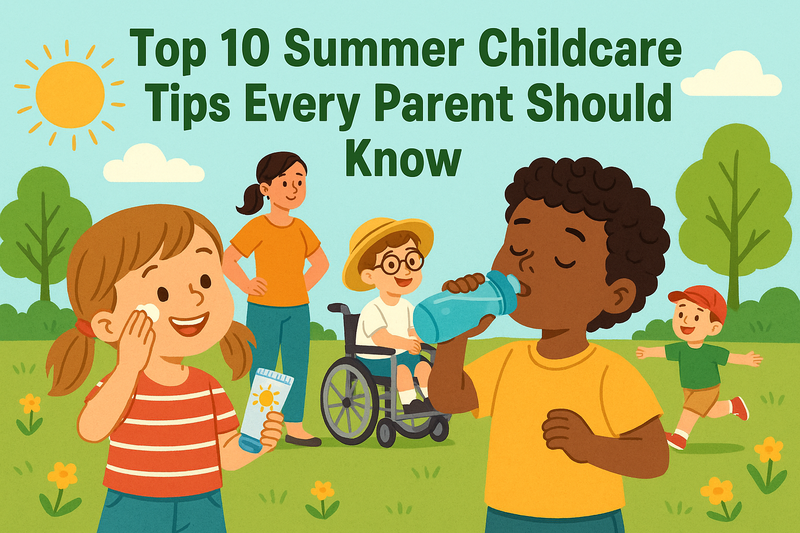
Keep your child safe, healthy, and happy this summer! Discover 10 expert-backed summer childcare tips every parent should follow—easy, fun, and effective.
Introduction
The final school bell rings, signaling freedom and fun for kids, but for many parents, it triggers the annual stress of navigating the summer childcare landscape. Finding arrangements that are reliable, enriching, affordable, and safe can feel like a monumental task, often referred to as the "summer scramble" or even the "summer camp Hunger Games". This search occupies significant mental space, adding to the already considerable mental load parents carry year-round. With the majority of parents working outside the home , the lack of the school day's structure presents a real challenge. Concerns about cost, quality, logistics, safety, and ensuring children have a positive, engaging experience are paramount. For more insights on parenting challenges and solutions, explore our main blog.
The reality is that finding suitable summer care often involves piecing together various options, managing complex schedules, and dealing with costs that can strain the family budget. This process isn't just about individual planning difficulties; it often reflects a broader challenge where the demand for high-quality, accessible, and affordable summer programs outstrips the available supply, creating inherent stress for families.
But navigating this challenge successfully is possible. This guide offers 10 essential, actionable tips, drawing on expert advice and shared parent experiences, to help plan a summer that’s less stressful for parents and more fun and fulfilling for children.
1. Plan Like a Pro (Start Early!)
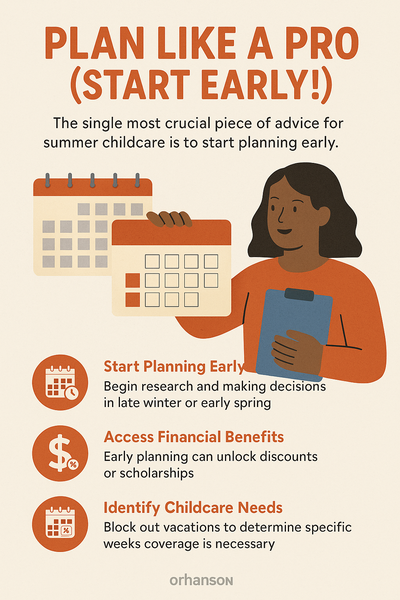
The single most crucial piece of advice for summer childcare is to start planning early. Much earlier than might seem necessary – ideally, begin research and making decisions in late winter or early spring, around January through March. This early timeline is essential for several reasons. Popular camps and high-quality programs fill up remarkably quickly, sometimes within hours of registration opening. The registration process itself can feel like a competitive sport, requiring parents to be ready the moment sign-ups begin, often navigating glitchy websites. Starting early provides the best access to preferred programs and specific weeks needed. Furthermore, early planning often unlocks financial benefits like early bird discounts or scholarships, making care more affordable.
This early rush isn't just driven by parental demand; it often aligns with when camps and organizations finalize their programs and open registration, typically holding fairs or releasing information during these winter months. Planning early means aligning with their schedule to secure spots.
Practical first steps involve grabbing a calendar covering June, July, and August. Block out any confirmed family vacations, visits from relatives, or planned time off work. This clearly identifies the specific weeks or days when childcare coverage is necessary. Be prepared for this planning phase to take significant time – research, comparing options, and completing registrations can consume hours. Also, bear in mind that certain weeks, particularly the very first week after school lets out and the last couple of weeks in August before school restarts, tend to have fewer camp options available. Planning should also anticipate the logistical complexities ahead, such as potentially learning entirely new drop-off and pick-up routines each week if using multiple camps , and managing the administrative burden of back-to-school paperwork, which often arrives in late summer.
2. Explore Your Options (Beyond Traditional Camp)
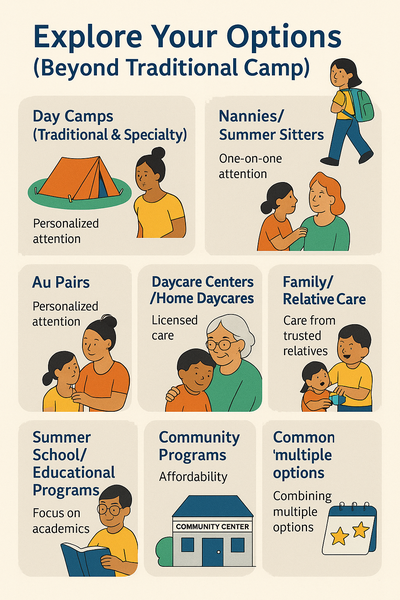
While "summer camp" is often the first thought, the landscape of summer childcare is diverse. Understanding the pros and cons of each option is key to finding the best fit for a family's specific needs, budget, schedule, and child's personality. There isn't a single "right" answer; the ideal solution is highly contextual. Consider this range:
- Day Camps (Traditional & Specialty): These offer structured activities, socialization, and opportunities to explore interests like sports, arts, STEM, or nature. They can foster skill development and provide engaging experiences. However, costs can be high, hours may be inflexible (often ending mid-afternoon, requiring additional care arrangements ), and popular camps have limited spots. Parents might need to combine several different camps to cover the entire summer, adding logistical complexity. Traditional camps may also not be suitable for very young children, like preschoolers.
- Nannies/Summer Sitters: Hiring a nanny or sitter provides personalized, one-on-one attention in the comfort of home. This option offers maximum flexibility in scheduling, is convenient (no commute), and ensures care even if the child is mildly ill. Some nannies may also handle light housekeeping or meal prep. The primary drawback is cost, as this is typically the most expensive option. Finding, vetting, and hiring a qualified caregiver requires significant effort, and there's always a risk of unreliability if the nanny gets sick or quits. Socialization with peers also needs to be actively arranged. Consider looking for college students (perhaps studying education) or teachers on summer break.
- Au Pairs: Offering live-in childcare, often through a cultural exchange program, au pairs provide personalized attention and flexibility. However, families must provide room, board, a stipend, and cover agency fees. Au pair arrangements usually last 12 months or longer, making them less suitable for summer-only needs. Like nannies, supervision is needed, and socialization must be arranged. There's also potential disruption if the au pair leaves unexpectedly.
- Daycare Centers/Home Daycares: These facilities offer reliable, licensed care with built-in socialization. They are often more affordable than nannies and provide a structured environment. Downsides include less individual attention due to group settings, which can also lead to more frequent exposure to illnesses. Many daycares require year-round enrollment and don't allow families to just "pop in" for the summer , although some may offer specific summer programs. Hours can be rigid, and they may close for holidays.
- Family/Relative Care: Care provided by grandparents or other relatives offers high trust, a personal investment in the child, and is often very inexpensive or free. Challenges can arise from differing childcare philosophies, making it difficult to establish clear expectations or provide feedback. Socialization opportunities need to be planned separately, and there is no formal oversight or regulation.
- Nanny Shares/Co-ops: Sharing a nanny with another family can reduce costs while still providing in-home care and built-in socialization. Childcare co-ops involve parents rotating caregiving duties. Both require finding a compatible family, agreeing on rules and logistics, and potentially dealing with space constraints in the home.
- Summer School/Educational Programs: Often offered by schools or community organizations, these programs focus on academics, helping prevent the "summer slide". Public school options can be affordable. However, they may only cover typical school hours and might not feel like a true break for some children.
- Community Programs: Local Parks and Recreation departments, libraries, places of worship, YMCAs, Boys & Girls Clubs, and similar organizations frequently offer summer programs or camps that are community-focused and often more budget-friendly.
- Hybrid/"Hodgepodge" Approach: Many families find success by combining several different options – perhaps a few weeks of specialty camp, some time with a sitter or relatives, and a week of family vacation. This offers variety and flexibility but requires meticulous planning, coordination, and can potentially become quite expensive.
While camps are often the default, in-home options like nannies offer significant advantages in flexibility and personalized care, which might be crucial for families with very young children, children with special needs, or parents with unpredictable work schedules. These benefits must be weighed against the typically higher cost and the effort involved in hiring and management.
3. Tip 3: Prioritize Safety & Staff Quality (Ask the Right Questions)
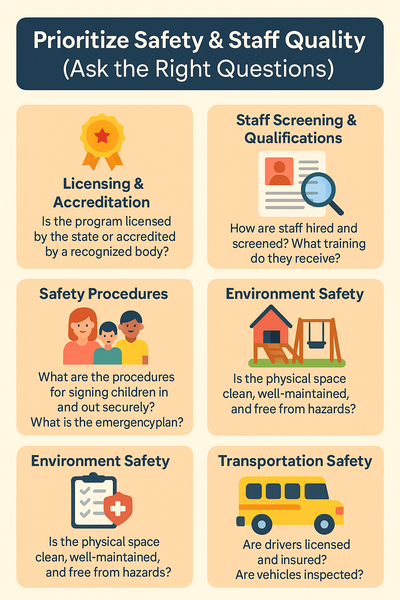
Regardless of the type of care chosen, safety and quality supervision are absolutely non-negotiable. Parents must be diligent investigators. While licensing provides a baseline, it's often not sufficient, especially as some summer camps may operate under different regulatory requirements or lack them entirely. Accreditation often indicates adherence to higher standards , but ultimately, parents need to ask detailed questions to feel confident. Trusting a program's reputation isn't enough; proactive vetting is essential. Use this checklist based on expert recommendations :
- Licensing & Accreditation: Is the program licensed by the state or accredited by a recognized body?
- Staff Screening & Qualifications: How are staff hired and screened? Crucially, this includes comprehensive background checks (local, state, and national FBI checks for all staff and volunteers). What training do they receive? Look for training in child development, age-appropriate activities, behavior management, CPR, First Aid, and specific needs like allergy management or lifeguarding (if applicable). What are the lead staff's qualifications and experience? Are programs developed by professionals with backgrounds in education or child psychology, not just staffed by teens? Effective staffing goes beyond supervision; it requires pedagogical knowledge and emergency skills.
- Supervision & Ratios: What is the staff-to-child ratio for your child's age group? (Note: Florida mandates 1:25 for school-age, but quality standards recommend much lower, like 1:8 to 1:15 ). How are children supervised during different activities, transitions, and less structured times? Are younger children always within sight and sound of a caregiver?
- Safety Procedures: What are the procedures for signing children in and out securely? What is the emergency plan for various scenarios (fire, medical issue, severe weather, missing child)? Are emergency drills practiced regularly? How are medications stored and administered? What is the policy for handling sick children? For guidance on managing allergies and dietary restrictions, which are key to safety, resources like NutriAI for personalized meal planning and our(recipes ) for allergen-free ideas can be invaluable. Is there a well-stocked first aid kit easily accessible?
- Environment Safety: Inspect the physical space. Is it clean, well-maintained, and free from hazards like broken toys, peeling paint, tripping risks, or accessible cleaning supplies/medications? Are electrical outlets covered? Is the outdoor play area safe and securely fenced? Are there shaded areas for rest and protection from sun/bad weather? Has the building been assessed for environmental hazards like radon, lead, or asbestos? Is smoking (including vaping) prohibited on the premises during operating hours?
- Transportation Safety: If the program transports children (e.g., for field trips), are the drivers properly licensed and insured? Are vehicles regularly inspected? Are children secured in age- and weight-appropriate safety seats? What are the specific field trip policies and supervision plans?
4. Tip 4: Look for Engaging & Enriching Activities (Balance Fun & Learning)
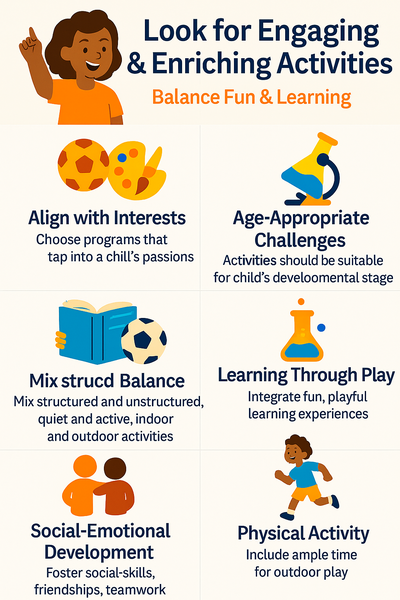
Summer care should be more than just supervision; it should be an opportunity for children to have fun, explore interests, socialize, and even continue learning in a relaxed setting. Look for programs that offer a stimulating and well-rounded experience:
- Align with Interests: Whenever possible, choose programs that tap into a child's existing passions, whether that's coding, soccer, drama, nature exploration, or art. Involving the child in the selection process can increase their excitement and buy-in.
- Age-Appropriate Challenges: Activities should be suitable for the child's developmental stage, offering the right level of challenge and engagement.
- Variety and Balance: A good program balances different types of activities throughout the day: structured and unstructured play, quiet time and active time, indoor and outdoor experiences, group projects and individual choices. Avoid programs with excessive, aimless downtime, which can lead to boredom or behavioral issues.
- Learning Through Play: Summer is an ideal time to combat "summer learning loss" or the "summer slide," but this doesn't mean replicating the school day. Look for programs that integrate learning opportunities naturally and playfully. This might involve hands-on science experiments, using math skills in crafts or cooking (for which you can find kid-friendly ideas in our(recipes ), creative writing or storytelling, nature-based exploration, or themed projects that apply academic concepts in real-world ways.
- Social-Emotional Development: Quality programs intentionally foster important social skills. They provide opportunities for children to make new friends, learn teamwork, practice communication and conflict resolution, and develop independence and responsibility. Camp is often a "crash course in community building".
- Physical Activity: Ensure the program includes ample time for running, playing, climbing, and other physical activities, ideally outdoors.
- See the Schedule: Don't hesitate to ask for a sample daily or weekly schedule or lesson plan to get a concrete sense of the program's structure and activities.
Finding the right activity balance can be tricky. While parents and educators often prioritize structured enrichment and preventing learning loss, especially in areas like STEAM (and for insights into how technology, including AI, is shaping modern parenting and childcare, see our article on AI-powered childcare), children also need the downtime, social connection, and freedom that summer represents. The most successful programs often strike this balance by making learning active, hands-on, and interest-driven, rather than purely academic , while still allowing for social growth and relaxation. Effective engagement comes from understanding children's learning styles and using interactive methods like games, projects, and exploration.
5. Tip 5: Navigate the Costs (Budgeting for Summer)

The cost of summer childcare is a significant hurdle for a vast number of families. It often represents a substantial new line item in the household budget, appearing only during the summer months. For some families, the expense can be prohibitive, potentially forcing difficult decisions about parental employment, such as reducing hours or changing jobs, leading to lost income. This highlights that the cost issue often extends beyond simple budgeting into broader socioeconomic challenges. While systemic solutions are needed, careful individual planning is essential:
- Budget Early: As part of the early planning process (Tip 1), determine a realistic weekly or overall summer budget for childcare. Knowing the financial parameters helps narrow down options.
- Uncover All Fees: The advertised tuition is often just the starting point. Actively inquire about all potential additional costs: registration fees, supply fees, charges for extended hours (early drop-off or late pick-up), costs for field trips or special activities, and whether meals and snacks are included or extra. These "hidden" costs can significantly increase the total expense. Planning nutritious and budget-friendly meals can be aided by resources like our(recipes ) or tools such as NutriAI for personalized meal suggestions.
- Seek Financial Assistance: Don't assume a program is out of reach based on the sticker price. Ask directly if they offer any financial aid, scholarships, tiered pricing based on income, or sibling discounts. Also, check if they accept government childcare subsidies, such as the Childcare and Parent Services (CAPS) program or assistance through the Child Care and Development Block Grant (CCDBG), although be aware that funding for these programs is often limited and doesn't reach all eligible families. For tips on maintaining a healthy diet during summer vacations without breaking the bank, check out our blog.
- Compare Option Costs: Factor cost into the evaluation when comparing different types of care (e.g., day camp vs. nanny share vs. community program). While nannies are often perceived as the most expensive, this isn't universally true; depending on the local market and the number of children needing care, a nanny might be comparable to or even cheaper than enrolling multiple children in a center or camp.
- Assess Value, Not Just Price: The cheapest option isn't always the best. Consider the overall value proposition: Does the program's quality, hours of operation, location convenience, staff qualifications, and alignment with the child's needs justify the cost? Sometimes paying slightly more for a program that perfectly fits the family's needs can reduce stress and provide a better experience overall.
6. Tip 6: Master Summer Health & Safety (Sun, Water, Bugs & More)
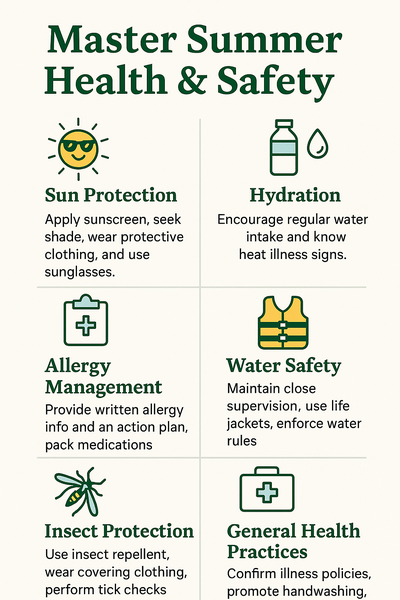
Summer brings unique health and safety considerations due to increased outdoor time and specific activities. Proactive prevention is key. Ensure the chosen provider has solid policies, and reinforce these habits:
- Sun Protection: This is non-negotiable.
- Sunscreen: Use broad-spectrum (UVA/UVB) sunscreen with an SPF of 30 or higher. Apply it generously 15-30 minutes before going outdoors to allow absorption. Reapply every two hours, and more often after swimming or heavy sweating. Provide written permission for staff to apply sunscreen. For more on sun safety for kids, we have a dedicated guide.
- Shade: Encourage seeking shade, especially during peak sun intensity hours (roughly 10 a.m. to 4 p.m.).
- Clothing: Dress children in lightweight, tightly woven clothing that covers arms and legs when possible. A wide-brimmed hat protecting the face, ears, and neck is essential.
- Eyes: Sunglasses that block UV rays protect children's eyes.
- Infants: Babies under 6 months have sensitive skin and should be kept out of direct sunlight, relying primarily on shade, protective clothing, and hats. Consult a pediatrician before using sunscreen on infants.
- Hydration: Dehydration is a serious risk in summer heat.
- Water Intake: Encourage frequent sips of water throughout the day, especially during active play, even if children don't feel thirsty. Send a reusable water bottle daily. For more hydration tricks for kids, see our dedicated article.
- Best Fluids: Water is the best hydrator. Avoid sugary drinks like soda or juice, which are less effective.
- Heat Illness: Know the signs of dehydration and heat exhaustion/heat stroke (extreme fatigue, headache, dizziness, nausea, fever, lack of sweat) and seek cool environments and medical help immediately if suspected. Our guide on how to spot heat exhaustion symptoms in kids can be helpful.
- Allergy Management: Clear communication and planning are vital for children with allergies.
- Inform Providers: Provide detailed, written information about all allergies (food, insect stings, environmental) and other medical conditions. Tools like NutriAI can help organize and manage this information for personalized meal planning.
- Action Plan: Work with the provider and doctor to create a clear, written Allergy Action Plan outlining specific allergens, symptoms of a reaction, and step-by-step treatment instructions. Ensure staff are trained on the plan and know where it's kept.
- Medication: Pack all necessary emergency medications (epinephrine auto-injectors, inhalers, antihistamines) in their original packaging, clearly labeled with the child's name and dosage instructions. Ensure they are not expired. Confirm the provider's policy on storing and administering medication.
- Safe Food: Discuss the program's food policies. Pack safe, allergen-free snacks and lunches if necessary or preferred. Find inspiration and suitable options in our extensive(recipes ), including ideas for sneaky veggies or meals for picky eaters. For families navigating specific dietary needs, such as veganism in kids, our blog offers further guidance.
- Other Needs: Use hypoallergenic sunscreen or soaps if needed for sensitive skin.
- Water Safety: Drowning is a leading cause of injury death for young children.
- Supervision: Constant, vigilant, active supervision ("within arm's reach" for young children) is essential whenever children are in or near any water, including pools, lakes, oceans, and even shallow wading pools or water tables. Never leave children unattended, even for a moment.
- Life Jackets: Use properly fitted, U.S. Coast Guard-approved life jackets for non-swimmers or weak swimmers near open water or on boats.
- Rules: Enforce water safety rules: no running near pools, no diving into water of unknown depth, no rough play. Pay attention to ocean conditions like rip currents.
- Visibility: Consider brightly colored swimsuits (neon orange, yellow, pink) for better visibility in water.
- Hygiene: Sprinklers and individual water basins are generally safer and more hygienic than communal wading pools. Ensure handwashing before and after water play.
- Playground Safety: Check that playground equipment is age-appropriate, well-maintained, and installed on a safe surface. Ensure active supervision. For more on the importance of outdoor play for child development, explore our blog.
- Insect Protection: Prevent bites from mosquitoes, ticks, and other insects.
- Repellent: Use an EPA-registered insect repellent appropriate for children (e.g., containing DEET 10-30% for children over 2 months). Apply according to instructions.
- Clothing: Cover up with clothing when in wooded or grassy areas.
- Checks: Perform thorough tick checks daily after outdoor play, paying attention to scalp, ears, armpits, and groin area.
- Avoid Attractants: Avoid using scented soaps or lotions that might attract insects.
- General Health Practices: Confirm the provider has clear policies for handling illness. Promote frequent handwashing among children and staff. Ensure the child's immunizations are up-to-date. For more on boosting child immunity naturally through diet and lifestyle, explore our resources.
- Emergency Preparedness: Verify the program has access to medical support if needed and clear emergency protocols. Consider packing a small personal first aid kit with essentials like bandages and antiseptic wipes. Knowing first aid fundamentals is crucial for every parent.
7. Tip 7: Build a Strong Parent-Provider Partnership (Communicate Effectively)
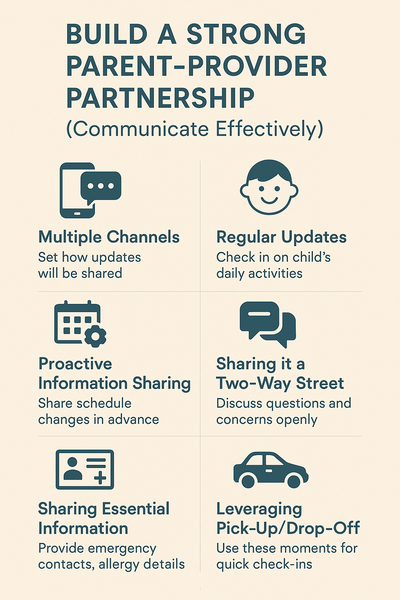
A positive summer childcare experience hinges on a strong partnership between parents and providers, built on open, consistent, and respectful communication. This builds trust and ensures everyone is aligned in supporting the child. Effective communication involves:
- Multiple Channels: Establish how communication will primarily occur. Many programs now use dedicated childcare management apps for updates, photos, and messaging, which aligns with modern parental expectations for frequent, even real-time, information. However, ensure options exist for families with limited tech access (phone calls, in-person chats, written notes). Clarify preferred channels for both routine updates and urgent matters.
- Regular Updates: Parents appreciate regular information about their child's day – activities they enjoyed, meals eaten, nap times, mood, and social interactions. Daily or weekly summaries, often facilitated by apps, help parents feel connected and informed.
- Proactive Information Sharing: Good providers share information proactively – upcoming schedule changes, special event reminders, policy updates. Likewise, parents should inform providers of anything relevant from home that might impact the child's day (e.g., poor night's sleep, upcoming family changes). Use designated channels (like mass notifications via an app) for urgent news like unexpected closures.
- Making it a Two-Way Street: Communication flows both ways. Parents should feel comfortable asking questions, sharing concerns, and providing feedback. Both parties should practice active listening, seeking to understand the other's perspective, and using respectful language, especially when addressing concerns. Approach issues constructively, focusing on solutions rather than blame.
- Sharing Essential Information: Ensure the provider has up-to-date emergency contact information, detailed allergy plans, and notes on any special needs or routines. Utilizing tools like NutriAI can assist in creating and sharing these dietary plans, and our(recipes ) can provide ideas for suitable meals. Parents, in turn, should make sure they understand the program's key policies regarding discipline, illness, pick-up authorization, etc..
- Leveraging Pick-Up/Drop-Off: These brief moments can be valuable for quick check-ins, sharing a positive anecdote, or flagging a minor issue. However, respect that staff are also managing other children and may not be available for lengthy conversations at these busy times. Schedule a separate call or meeting if more discussion is needed. For more on mindful parenting and staying present during these interactions, visit our blog.
- Cultural Sensitivity and Accessibility: Recognize and respect diverse family backgrounds, values, and communication styles. Ensure communication is accessible, making accommodations for language barriers or varying levels of technological access.
Building this partnership requires mutual respect. Providers appreciate parents who follow program rules (like labeling belongings and adhering to pick-up times) and communicate needs clearly. Parents value providers who listen, respond, and keep them informed.
8. Tip 8: Prepare Your Child for the Change (Ease the Transition)
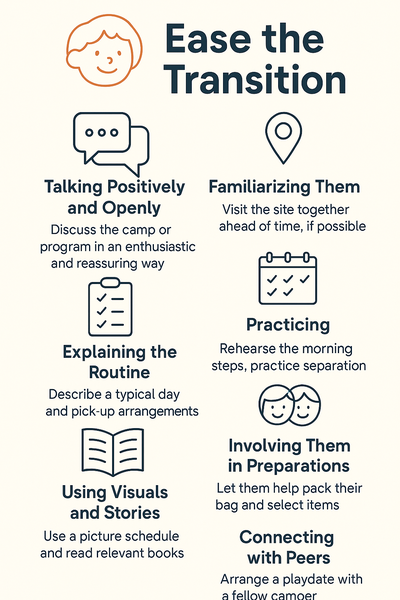
Starting a new summer camp or childcare arrangement is a significant transition for a child, potentially bringing up feelings of uncertainty or anxiety, especially for younger children or those new to care outside the home. Reducing the "unknowns" is a powerful strategy for easing this shift. Help prepare them by:
- Talking Positively and Openly: In the days and weeks leading up, talk enthusiastically about the new camp or program. Focus on the fun activities, the chance to make new friends, and exciting things they might learn or do. Frame it as an adventure. Ask them what they are looking forward to or what they hope to do. Acknowledge that feeling a little nervous is normal.
- Familiarizing Them: If possible, visit the camp or center together before the first day. Walk around, see the play areas, and meet the counselors or teachers. Looking at photos on the program's website can also help.
- Explaining the Routine: Walk them through what a typical day will involve: arrival and drop-off, types of activities, mealtimes, rest time (if applicable), and pick-up. Knowing the sequence of events provides predictability. Clearly explain who will be picking them up and approximately when.
- Practicing: Rehearse the morning routine to make the first day less rushed. If the child hasn't spent much time away from primary caregivers, practice short separations beforehand. Leave them with a trusted friend or relative for gradually increasing periods, always returning when promised.
- Using Visuals and Stories: For younger children, a simple visual schedule with pictures representing different parts of the camp day can be very helpful. Reading age-appropriate books about starting camp or school can normalize the experience and address potential worries.
- Involving Them in Preparations: Let the child help choose their backpack, water bottle, or lunchbox for camp. Involve them in packing their bag with necessary items (sunscreen, hat, swimsuit, etc.). This gives them a sense of ownership and control.
- Connecting with Peers: If possible, arrange a playdate before camp starts with another child who will be attending the same program. Knowing a friendly face on the first day can make a big difference. Consider enrolling them with a friend from school if feasible.
Emotional preparation—managing expectations and building positive associations—is just as important as these practical steps.
9. Tip 9: Address Separation Anxiety Sensitively (Yours and Theirs)
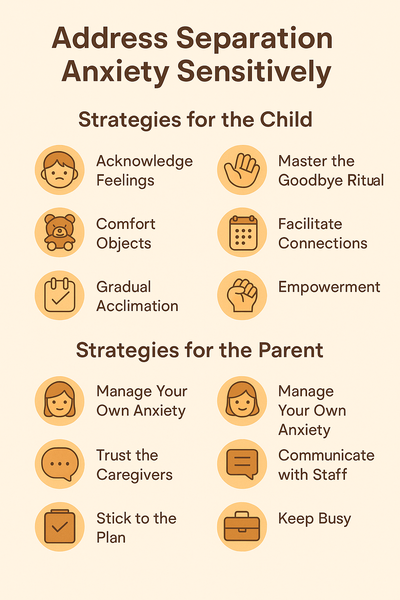
Tears and clinginess at drop-off are common, especially during the initial adjustment period or for younger children experiencing separation for the first time. It's important to handle these moments with sensitivity and consistency.
- Strategies for the Child:
- Acknowledge Feelings: Validate their emotions. Let them know it's okay to feel sad or scared when saying goodbye, and that missing family is normal. Avoid dismissing their fears.
- Master the Goodbye Ritual: This is crucial. Keep goodbyes brief, positive, and confident. Express love, give a hug and kiss, clearly state you will be back (e.g., "I'll be back after snack time"), and then leave promptly. Lingering or showing hesitation often prolongs the distress. Using phrases like "See you later" can feel less final than "Goodbye".
- Comfort Objects: Allow a small, familiar item from home – a family photo, a special blanket or stuffed animal (if permitted by the program), or even a parent's t-shirt worn the previous day. Rituals like the "Kissing Hand" can also offer comfort.
- Facilitate Connections: Encourage the child to connect with a specific teacher or counselor upon arrival. Help them join an activity or connect with another child quickly. Ask staff to help engage the child immediately after the parent leaves.
- Gradual Acclimation: If possible, start with shorter days or periods of separation and gradually increase the time as the child becomes more comfortable.
- Empowerment: Give the child a small "job" to do upon arrival. Teach simple calming affirmations they can repeat ("Mommy/Daddy always comes back").
- Strategies for the Parent:
- Manage Your Own Anxiety: Children are highly attuned to parental emotions. Projecting confidence in the child's ability to cope and trust in the program sends a reassuring message. Parental anxiety can inadvertently reinforce the child's fear.
- Trust the Caregivers: Experienced childcare providers and camp counselors have dealt with separation anxiety many times. Trust their ability to comfort and redirect the child once the parent has left. Often, the crying stops shortly after the parent is out of sight.
- Communicate with Staff: Share concerns with the teachers or director. Collaborate on drop-off strategies that work best for the child. Don't hesitate to ask for a quick update later in the morning if feeling worried.
- Stick to the Plan: Resist the urge to linger or return if the child is crying. Follow through with the brief, positive goodbye. Sneaking out without saying goodbye can erode trust and worsen anxiety long-term.
- Keep Busy: After drop-off, focus on work or other tasks to manage personal worry.
10. Tip 10: Foster Continued Growth & Fun (Keep Them Engaged All Summer)
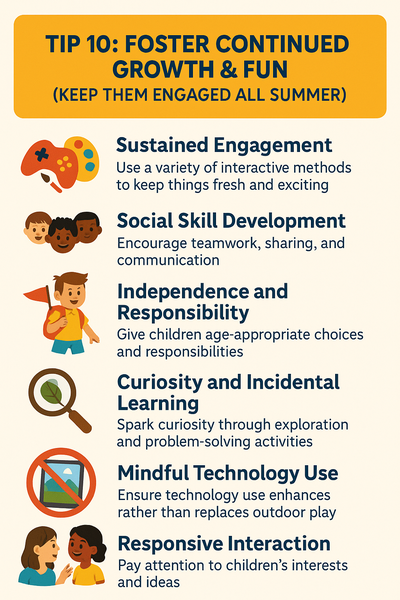
A successful summer program does more than just fill time; it actively engages children, fostering their growth and ensuring they have fun throughout the weeks. Quality programs achieve this through intentional strategies, and parents can look for these elements:
- Sustained Engagement: Programs should use a variety of interactive methods – games, hands-on projects, creative arts, nature exploration, team challenges – to keep things fresh and exciting. Minimizing passive screen time or long stretches of unstructured "down time" is important for maintaining focus and preventing boredom. Staff enthusiasm and positive energy are contagious.
- Social Skill Development: Summer provides a prime opportunity for children to practice interacting with peers in a less formal setting than school. Look for programs that actively encourage teamwork, sharing, communication, and provide guidance on resolving conflicts respectfully. These "soft skills" are invaluable life lessons.
- Independence and Responsibility: Age-appropriate opportunities for children to make choices, manage their belongings, help with simple tasks (like tidying up or carrying equipment), and take initiative build confidence and self-sufficiency.
- Curiosity and Incidental Learning: Learning shouldn't stop in the summer, but it can look different. Engaging programs spark curiosity through exploration, asking questions, simple experiments, storytelling, reading for pleasure, and problem-solving activities integrated into play. Using the surrounding environment, whether it's a park, nature center, or even city landmarks, as a "classroom" makes learning tangible and fun. For ideas on making food fun and educational, explore our superpower foods guide or our yummy adventures guide to healthy foods.
- Mindful Technology Use: If technology is part of the program, ensure it's used purposefully to enhance activities (e.g., nature identification apps, digital storytelling) rather than replacing valuable outdoor play and face-to-face interaction. For many children, summer offers a welcome break from screens. For insights on balancing screen time and mealtime or the broader role of AI and tech in transforming childcare, our blog offers valuable perspectives.
- Responsive Interaction: Effective staff listen to children, respond to their interests and needs, and ask open-ended questions to stimulate thinking, rather than just issuing directives.
- Flexible Structure: While summer allows for more freedom, maintaining some level of routine and predictability provides security for children and can make the eventual transition back to the school year schedule smoother.
Ultimately, keeping children truly engaged involves more than just a busy schedule. It relies on the quality of interactions, the opportunity for choice and active participation, and making activities meaningful and enjoyable.
Conclusion
Navigating the world of summer childcare presents undeniable challenges for parents – from the logistical hurdles of early planning and registration to the significant financial considerations and the crucial task of ensuring a safe, engaging, and positive experience for their children. The "summer scramble" is a real phenomenon driven by complex factors including cost and availability.
However, armed with information and a proactive approach, parents can successfully manage this process. By starting the search early, thoroughly exploring the diverse range of options, diligently vetting potential providers for safety and quality, and prioritizing open communication, families can find arrangements that work. Preparing children for transitions, addressing separation anxiety with sensitivity, focusing on health and safety protocols, and seeking out truly engaging activities are all vital components of a successful summer plan.
Remember, the goal isn't just to find any childcare, but to find the right fit – an arrangement that aligns with the family's budget and schedule, and, most importantly, supports the child's individual needs, interests, and well-being, including their nutritional health. Resources like NutriAI for personalized nutrition advice and our(recipes ) for healthy meal ideas can be great aids. For more parenting tips and discussions, visit the KidyPulse blog or our homepage.
Sources used in this blog :
Childcare options: Pros and cons of daycare and nanny care | BabyCenter
Common Coparenting Issues: Summer Camps and Childcare - Hofheimer Family Law Firm
DayCare vs. Nanny: What's Best?
7 Biggest Mistakes Parents Make When Choosing a Summer Day ...
School-Age Child Care and Camp Programs - ChildCare.gov
How Parents Can Help Kids Navigate Social Challenges at Summer ...
Childcare Arrangements: Pros + Cons - CorporetteMoms
4 Common Challenges Parents Face During the Summer and How to Manage Them
Diverse Summer Childcare Options for Every Kid! - KinderPage
Why Booking Summer Camp Early Matters: Insider Tips for Parents
What Do Working Moms Do in the Summer - 12 Practical Strategies - Kelly Nolan
5 Popular Child Care Options for Summer - UrbanSitter Blog
Childcare options for the summer - Babysits
How do parents handle the long summer break regarding childcare? - Reddit
Finding Summer Child Care: Options for Every Family - Wonderschool
When Parents Can't Find Summer Child Care, Their Work Suffers
Summer Camp Guide 2025 for Parents | Tips for Young Kids
Planning for Summer Child Care; When to start, and what are my options? - Camp Fire First Texas
Parents say the 'summer camp scramble' is getting out of control - Care.com
When to start planning for summer camp | Parenting Behavior - YouTube
How to Solve the Summer-Child-Care Nightmare : r/Economics - Reddit
Choose the Perfect Summer Camp for Your Child in 5 Simple Steps ...
The Working Mom's Guide to Planning Summer Childcare | AllMomDoes
Jump Start Your Planning for Summer Camps and Child Care
Planning for Summer - Webinar - Child Care Aware
Need summer child care? Start looking now | Human Resources

Comments
No comments yet. Be the first to leave a comment!